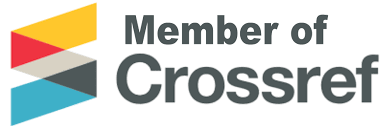Modified Value-Based Adoption Model (VAM) in Paid Entertainment Mobile Apps in Yogyakarta
Abstract
After the outbreak of COVID-19, there was an increase in the download of mobile applications because at that time there were regulations that required people to stay at home and maintain social distance. This has made changes to the lifestyle of consumers, some of them are no longer satisfied using the application alone but voluntarily pay to enjoy more offers in the application. We used a modified VAM to explain the intention of adoption through a benefit-sacrifice approach. Therefore, the purpose of this study is to determine the factors that influence adoption intention through the perceived value. This research uses path analysis method on 100 paid mobile entertainment application users in Yogyakarta. The results indicate that the enjoyment and perceived fee are proven to affect the perceived value and the perceived value has a significant effect on the intention of consumer adoption in the use of paid mobile applications.
Keywords
Full Text:
PDFReferences
Ajzen, I., & Fishbein, M. (1977). Attitude-Behavior Relations: A Theoretical Analysis and Review of Empirical Research. Psychological Bulletin, 84(5), 888–918.
Chin, W. W. (1998). The Partial Least Squares Approach to Structural Equation Modeling. In G. A. Marcoulides (Ed.), Modern Methods for Business Research (pp. 295–336). Lawrence Erlbaum Associates.
Chong, X., Zhang, J., Lai, K. K., & Nie, L. (2012). An empirical analysis of mobile internet acceptance from a value-based view. International Journal of Mobile Communications, 10(5), 536–557. https://doi.org/10.1504/IJMC.2012.048886
Davis, F. D. (1989). Perceived usefulness, perceived ease of use, and user acceptance of information technology. MIS Quarterly: Management Information Systems, 13(3), 319–340. https://doi.org/10.5962/bhl.title.33621
Kim, H. W., Chan, H. C., & Gupta, S. (2007). Value-based Adoption of Mobile Internet: An empirical investigation. Decision Support Systems, 43(1), 111–126. https://doi.org/10.1016/j.dss.2005.05.009
Kim, Y., Park, Y., & Choi, J. (2017). A study on the adoption of IoT smart home service: using Value-based Adoption Model. Total Quality Management and Business Excellence, 28(9–10), 1149–1165. https://doi.org/10.1080/14783363.2017.1310708
Lau, C. K. H., Chui, C. F. R., & Au, N. (2019). Ex-amination of the adoption of augmented reality: a VAM approach. Asia Pacific Journal of Tourism Research, 24(10), 1005–1020. https://doi.org/10.1080/10941665.2019.1655076
Mufingatun, M., & Prijanto, B. (2020). Analysis of Factors Affecting Adoption of Mobile Banking Application in Indonesia. Esensi: Jurnal Bisnis Dan Manajemen, 10(1), 31–44. https://doi.org/10.15408/ess.v10i1.13972
Nugroho, P., Winarno, W. W., & Hartanto, R. (2017). Faktor-Faktor Yang Mempengaruhi Niat Menggunakan Mobile payment Dengan Pendekatan Extended The Uni-fied Theory of Acceptance and Use of Technology. CITEE, 226–233.
Putri, A. I. A., & Gunawan, J. (2020). Identifikasi Faktor-Faktor Yang Mempengaruhi Per-ceived Value Terhadap Niat Adopsi Mobil Ramah Lingkungan. Jurnal Sains Dan Seni ITS, 9(1). https://doi.org/10.12962/j23373520.v9i1.50611
Roostika, R. (2012). Mobile Internet Acceptance among University Students: A Value-based Adoption Model. International Journal of Research in Management & Technology, 2(1), 21–28.
Shintaputri, I., & Wuisan, A. J. (2017). The Impact of Perceived Price Towards Perceived Value Through the Mediation of Perceived Quality : A Case of Brand X Smartphone in Indonesian Middle-Class Customers. IBuss Management, 5(1), 29–42.
Wang, Y. Y., Wang, Y. S., Lin, H. H., & Tsai, T. H. (2019). Developing and validating a model for assessing paid mobile learning app success. Interactive Learning Environments, 27(4), 458–477. https://doi.org/10.1080/10494820.2018.1484773
Werts, C. E., Linn, R. L., & Jöreskog, K. G. (1974). Intraclass Reliability Estimates: Testing Structural Assumptions. Educational and Psychological Measurement, 34(1), 25–33. https://doi.org/10.1177/001316447403400104
Zeithaml, V. A. (1988). Consumer Perceptions of Price, Quality, and Value: A Means-End Model and Synthesis of Evidence. Journal of Marketing, 52(3), 2–22. https://doi.org/10.1177/002224298805200302
DOI: https://doi.org/10.35314/inovbiz.v10i1.2375
Refbacks
- There are currently no refbacks.
Copyright (c) 2022 Lusia Tria Hatmanti Hutami, Bernadetta Diansepti Maharani, Bernadetta Diansepti Maharani

This work is licensed under a Creative Commons Attribution-NonCommercial-ShareAlike 4.0 International License.
This Journal has been listed and indexed in :
Copyright of Jurnal Inovasi Bisnis (p-ISSN : 2338-4840, e-ISSN : 2614-6983)

Inovbiz: Jurnal Inovasi Bisnis is licensed under a Creative Commons Attribution-NonCommercial-ShareAlike 4.0 International License.
Editorial Office :
Pusat Penelitian dan Pengabdian kepada Masyarakat
 Politeknik Negeri BengkalisÂ
Jl. Bathin alam, Sungai Alam Bengkalis-Riau 28711Â
E-mail: inovbiz@polbeng.ac.id














